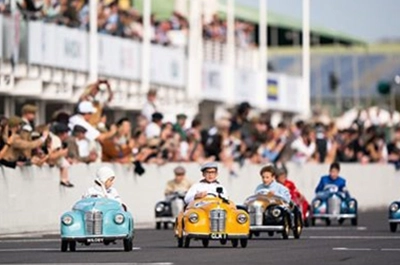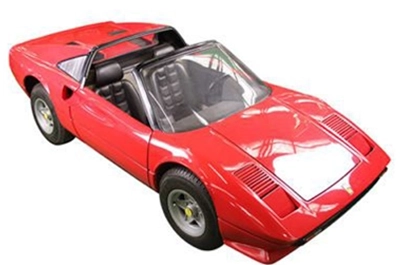28 August 2024
Pedal cars are not just child’s play
5 minutes
It is no coincidence that the price of classic pedal cars has risen sharply since the Goodwood Revival’s Settrington Cup race for children began more than a decade ago
Over the last decade or so, Goodwood Revival’s Settrington Cup for children aged four to eleven has become one of the much-loved races of the famous weekend of motorsport.
Mainly Austin J40 pedal cars are entered into the race which has a Le Mans-style start, with around forty young drivers dressed in traditional racing gear, sprinting to their cars.
The children start pedalling as fast as they can along the 217m (238yds) course with a serious race commentary adding to the excitement.
|
(Image: Settringham Cup. Ph by Nick Duggan) |
(Image: Settringham Cup. Ph by Stephanie O’Callaghan) |
The Settrington Cup is named after the Baron of Settrington; the only one of the Duke of Richmond’s nine titles that did not have a race named after it – the Duke is owner of the Goodwood Estate, in West Sussex.
Any factory-standard pedal car can be entered, but a car with aftermarket parts or modifications means owners should speak to the eligibility team before the race weekend. All of the Austin J40s participating in the race are checked by the eligibility stewards at the event.
Built by disabled miners
The J40s were built post-war by former coal miners after the 1943 Workmen's Compensation Act, to help those with pneumoconiosis (a lung disease caused by coal dust that affected many mining communities).
Disabled miners were given opportunities to continue their earning power which included retraining to build pedal cars at a new factory in Bargoed, South Wales.
|
|
Production started in 1949, initially with the A40 Pathfinder Special, a single seat racing car, which was replaced by the two-seater J40 Roadster a year later. This car boasted a lift-off bonnet, handbrake, boot and chrome bumpers, plus a horn and lights that worked off a battery. Children could even jack up the car and play with the dummy engine block and spark plugs. The J40s were a big hit around the world and survived because they were so well-made and beautifully painted. When you see the British-made J40, it is difficult not to admire the quality. (Image: Austin J40’s at the Goodwood Revival. Ph. By Jason Fong) |
Price acceleration
Toby Wilson, Head of Bonhams Automobile department, says it is no co-incidence that since the race began, prices of the curvy Austin J40 pedal cars and other quality models have risen in price. He said: “In 2012, prices were around £700-£1,000 for good examples, now they fetch £3,000-£7,000. An Austin J40 pedal car will feature in both Bonhams’ Goodwood revival sale on September 7, 2024 and the Beaulieu autojumble sale on September 13/14 with estimates at £1,500-£2,500.
£7,000 TV Star
A restored Austin J40 pedal car is the star of UKTV Play programme ‘Bangers & Cash: Restoring Classics’ due to be aired later this year. The car was bought for £2,150 in October 2023, in ‘a fairly solid condition but looking sorry for itself’. The Austin Pedal Cars’ restoration team at Bicester Heritage, Oxfordshire, returned the car to its original Ash Green colour, removed parts that suggested life on a fairground ride and reverted it to pedal specification.
It was unveiled at the Bicester Heritage, the UK’s centre of excellence for classic cars and home Howden’s specialist classic car team, and declared one of the best available J40s on the market.
Visit austinpedalcars.com for more information
Dream Machines
Toby Wilson says the history of children’s cars goes back much further than the 1940-50s. He said: “Children always want to be grown up and when they see their parents driving a car, they want to drive too. A pedal car has been the answer – or perhaps a go-kart with pram wheels holding up a wooden crate!
“Almost since time began hand-made wooden sheep carts, goat carts and dog carts have all been transformed into children’s playthings. The earliest pedal cars we see are late Victorian, from the 1890s – 1901; there are some Edwardian models but not many survive, although they do occasionally turn up in garages and attics.
“These cars were commissioned by wealthy car owners who could afford an expensive vehicle and would often commission a small model, coach-built by the same company. They were excellent hand-painted miniatures of the parents’ car.
“The 1930s golden age of motoring saw the production of lovely mini SSK Mercedes and the Bugatti baby type 52, probably the pinnacle of the market, as well as scale replicas of Alfa Romeos and American cars such as Cadillacs and Oldsmobiles.
“Department stores including Gamidges and Harrods in London also sold pedal cars representative of the time such as Rolls Royce and Bentleys as well as say, a Vauxhall, so children were driving the same sort of car as their parents.
|
(Image: An Austin J40 pedal car, British) |
(Image: A Vauxhall child’s pedal car by Lines Brothers, British 1930’s) |
|
(Image: Porsche 936 Junior petrol-powered child’s car) |
(Image: Ferrari 308 Dino AutoJunior by Agostini, Italian 1984) |
“Sir Malcom Campbell’s son Donald had a pedal-powered Bluebird and F1 champion Graham Hill gave his son Damon a pedal racing car – so there has long been a dream that your child could become a champion, too!
“Into the late 1960s and early 1970s, fibreglass pedal cars arrived on the scene as well as moulded plastic bodies on a metal frame with metal detailing. But over time, plastic became brittle and faded – so only a few good examples survive.
“However, Meynell Philips and Company produced 150 vehicles based on a 1929 supercharged Bentley Blower Le Mans team car. They were special because the children no longer had to pedal, these cars were battery powered with 12-volt electric motor – and much more like a modern car with four-wheel brakes and variable speed control.”
Toby Wilson’s tips for buying a pedal car
- Buy carefully, as if purchasing a full-size car
- Consider the condition and look at any repair history
- Watch out for replicas
- Turn over the car to look for rust on the underside. It may be shiny on the surface but not necessarily well restored
- Check the tracking in case it has taken a bashing over the years
Insuring a pedal car
Generally a pedal car is covered under the general contents section of a home insurance policy. However, if you have an antique pedal car or a collection of pedal cars then it should be in the valuables section of your policy with an agreed value.
Some of these little cars have engines, but as long as the engine size is below 50cc then this is fine as they are not road registered, but if in doubt then check with your insurer.
If you have a pedal car, or a road worthy classic, then why not speak to us about your insurance. Call 01869 943496 or email privateclients@howdeninsurance.co.uk to get in touch.
Goodwood Revival on runs from Friday, September 6 – Sunday, September 8, 2024.
Visit Goodwood.com







